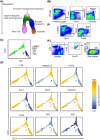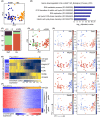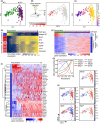Single-cell molecular profiling provides a high-resolution map of basophil and mast cell development
- PMID: 33078414
- PMCID: PMC8246912
- DOI: 10.1111/all.14633
Single-cell molecular profiling provides a high-resolution map of basophil and mast cell development
Abstract
Background: Basophils and mast cells contribute to the development of allergic reactions. Whereas these mature effector cells are extensively studied, the differentiation trajectories from hematopoietic progenitors to basophils and mast cells are largely uncharted at the single-cell level.
Methods: We performed multicolor flow cytometry, high-coverage single-cell RNA sequencing analyses, and cell fate assays to chart basophil and mast cell differentiation at single-cell resolution in mouse.
Results: Analysis of flow cytometry data reconstructed a detailed map of basophil and mast cell differentiation, including a bifurcation of progenitors into two specific trajectories. Molecular profiling and pseudotime ordering of the single cells revealed gene expression changes during differentiation. Cell fate assays showed that multicolor flow cytometry and transcriptional profiling successfully predict the bipotent phenotype of a previously uncharacterized population of peritoneal basophil-mast cell progenitors.
Conclusions: A combination of molecular and functional profiling of bone marrow and peritoneal cells provided a detailed road map of basophil and mast cell development. An interactive web resource was created to enable the wider research community to explore the expression dynamics for any gene of interest.
Keywords: basophils; differentiation; mast cells; single-cell RNA sequencing; transcriptomics.
© 2020 The Authors. Allergy published by European Academy of Allergy and Clinical Immunology and John Wiley & Sons Ltd.
Conflict of interest statement
The authors declare that they have no competing interests.
Figures




References
-
- Nathan C. Points of control in inflammation. Nature. 2002;420:846‐852. - PubMed
-
- Akashi K, Traver D, Miyamoto T, Weissman IL. A clonogenic common myeloid progenitor that gives rise to all myeloid lineages. Nature. 2000;404:193‐197. - PubMed
-
- Drissen R, Thongjuea S, Theilgaard‐Monch K, Nerlov C. Identification of two distinct pathways of human myelopoiesis. Sci Immunol. 2019;4:eaau7148. - PubMed
Publication types
MeSH terms
Grants and funding
LinkOut - more resources
Full Text Sources
Molecular Biology Databases

